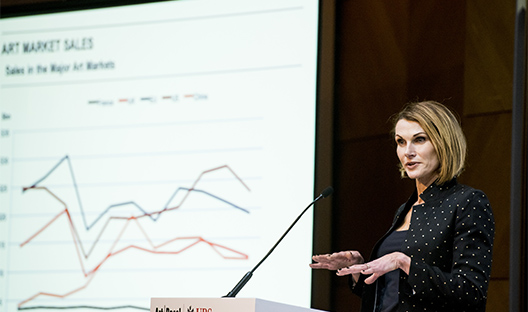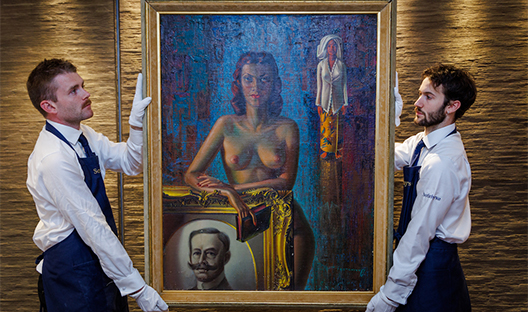The findings in the global art market reports issued by professional services firms – Deloitte and UBS – and Artnet all seem to arrive at the same conclusion; the art market is in decline. This trajectory happens to mirror (to some degree) the fate of the HNW individuals, whose wealth appears to be shrinking.
In measuring the temperature of the art market, researchers and art market specialists tend to study the habits and consumption patterns of the uber-wealthy, high-net-worth (HNW) individuals. While it is possible to buy artwork for under R1,000, and art collecting has in recent times become a middle-class pursuit, in reality, the art market is sustained by billionaires.
Reports on the global art market released in 2023, found that the reduction of wealth has sent ripples through the art market, resulting in decreased income for auction houses, high-valued works not coming to the market and collectors opting to take fewer risks.
The African continent is presumed to only claim 1% of global wealth, according to The Art Basel and UBS Survey of Global Collecting, however, many of our artists and most prominent art dealers are participating in the global art market, so shifts that take place at the high-end are likely to have some impact on our shores.

International versus local auctions
As auction art houses revenue is publicly shared, this is where shifts in the art market are typically gauged. When an analysis of 2023 auction results at the three major art auction houses – Sotheby’s, Christies and Phillips – showed a decline of 16% in year-on-year revenue, shudders were felt across the art market.
But this pessimistic outlook was tempered by results from other auction houses – such as Bonhams (which has an African Art department), which enjoyed much healthier figures. This led the authors of the The Art Basel and UBS Survey of Global Collecting, to conclude that buyers were opting for less expensive, more ‘conservative’ artworks, which they presumed were more often offered at this London-based auction house.
Last year’s sales were good at Bonhams African Modern and Contemporary, says Giles Peppiatt, Group Head, Fine Art (UK). However, “in the second half (August to December) we did notice that some of the froth was blown from the market. We had a strong sale in October, but some works that we thought would outperform their estimates did not. Our sell-through rate was still good, as works did sell.”
When you peruse a comparison of auction results publicised by the dominant art auction house, Strauss & Co, in the first six months of 2022 to the same period in 2023 a rosier picture emerges with an 11% increase in revenue last year. While there were more auctions in 2023, which presented more opportunities to make sales, the overall number of lots offered in 2023 was less than in 2022. Significantly, the average sell-through rate in this period was also higher.
“It has been a mixed bag for auction sales in 2023. In many instances, the second half of the year delivered much better results than the first half as confidence returned to the market. Overall sales for the year, excluding charity sales, amounted to R372.8m, an increase of R12m on 2022."
Frank Kilbourn, executive chairman at Strauss & Co.
Absence of high-valued artworks
The Deloitte Art & Finance Report 2023, attributed the decrease in revenue at the major auction houses to a 51% decline in high-end artworks being offered up for sale. High-end pertains to works priced from US$10 million. It is tricky to conclude that an absence of high ticket works immediately signifies a downturn in the art market or if sellers are simply feeling sheepish due to the economic climate and their perceived impact of it on art sales.
In the South African context, auction houses also experienced a decrease in high-priced works for sale, though some records for African and South African artists were achieved. Kilbourn believes that confidence in the financial market impacts the art market.
“High-value items will come to the market when sellers are confident that market conditions are supportive of high sales volumes and prices,” says Kilbourn.
Mixed bag for auction sales
16%
11%
51%

Macroeconomic factors like high inflation and high-interest rates create financial vulnerability and low consumer confidence. Equity and bond markets experienced large drawdowns in 2022 and high net worth families who invest in these financial assets would have felt the brunt coming into 2023.
HNW South Africans were also burdened by national problems, which may influence their spending – or confidence to spend.
“The situation in South Africa was exacerbated by load shedding, continued corruption and a lack of confidence in the future of the country, hence the rush to dollar-based assets,” observed Kilbourn.
The downturn in the revenue of art sales is not simply down to a lack of confidence in bringing high-priced works to the market, but a reduction in HNWs wealth. There has been a decrease of 2% in total net private wealth, according to the UBS 2023 Survey of Global Collecting.

Pictured: Lot82 Vladimir Grigoryevich Tretchikoff- Lenka's Family. On view at Sotheby's Oct 2023
HNW individuals spending less on art
This same report found in their survey of collectors that they were spending less on art.
In 2021, 48% of collectors were willing to buy works over US$100,000, whereas in 2022 only 31% indicated they would do so. The percentage of big spenders who could afford artworks over $1 million also fell substantially from 12% to 4%. The first quarter of 2023 saw an upward shift in these percentages, but it was reported to be marginal.
Yet as a market for an artist’s work is not necessarily linked to financial markets, certain artworks are viewed by some as a hedge asset. The Artnet Index Report shows that art is a reliable investment in times of economic strife, given that “fine art exceeded the S&P 500’s performance between January 2022 and July 2023”.
However, as the UBS report identified 43% of the HNW collectors in their survey are borrowing money to buy art, increased interest rates could have a direct impact on their art acquisitions, as could a need for more liquid or income-producing assets.
In South Africa, “art-related wealth management strategies to preserve or grow wealth are yet to take form in South Africa. Investors here are still primarily motivated by their own interest and passion to collect,” believes Ramatlo.
Art is more than an investment
Not everyone buys art for investment reasons. The Deloitte Art & Finance report showed that a rising number of younger collectors are interested in the social impact of acquisitions – how artists, dealers and the communities they support benefit from the sale of art.
African art remains undervalued in comparison to art produced in Europe and America – and this presents a lower risk for those looking to invest in art, as less capital is required to amass art from Africa.
Many European collectors attribute this as a motivation for almost exclusively buying art from Africa. The auction results at Strauss & Co also instil confidence, as does the fact that the Investec Cape Town Art Fair, which takes place from 16 to 18 February, grows in size every year.

